Desktop Virtualization Market Size
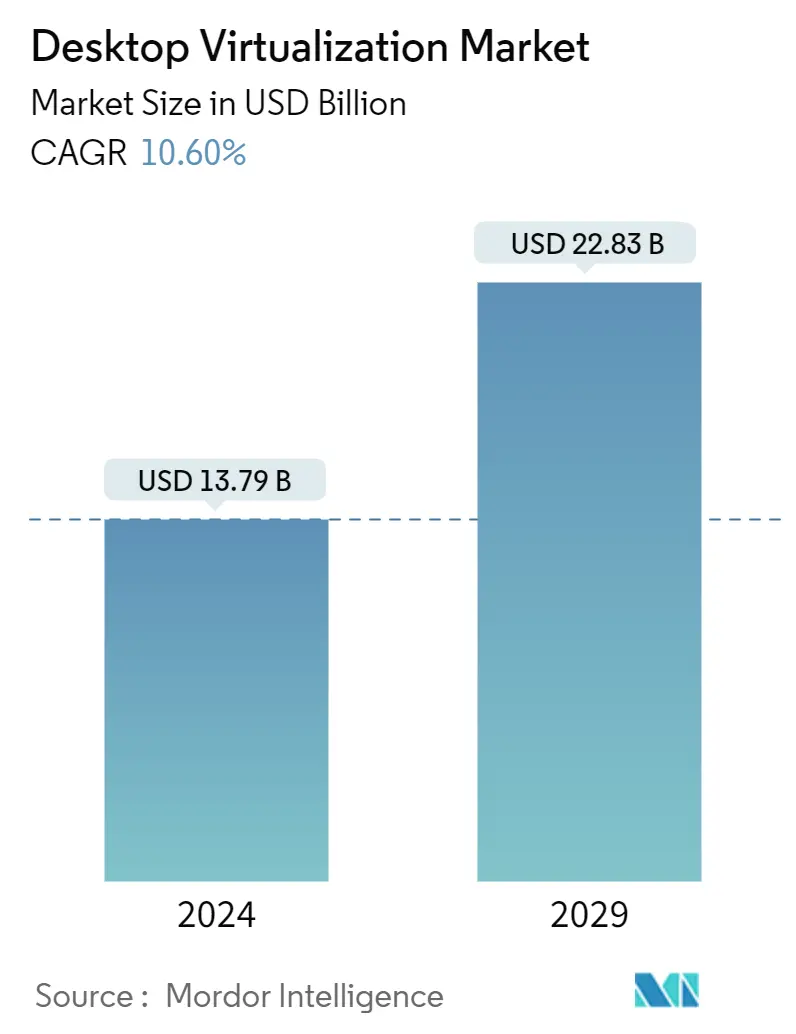
| Study Period | 2019 - 2029 |
| Market Size (2024) | USD 13.79 Billion |
| Market Size (2029) | USD 22.83 Billion |
| CAGR (2024 - 2029) | 10.60 % |
| Fastest Growing Market | Asia Pacific |
| Largest Market | North America |
Major Players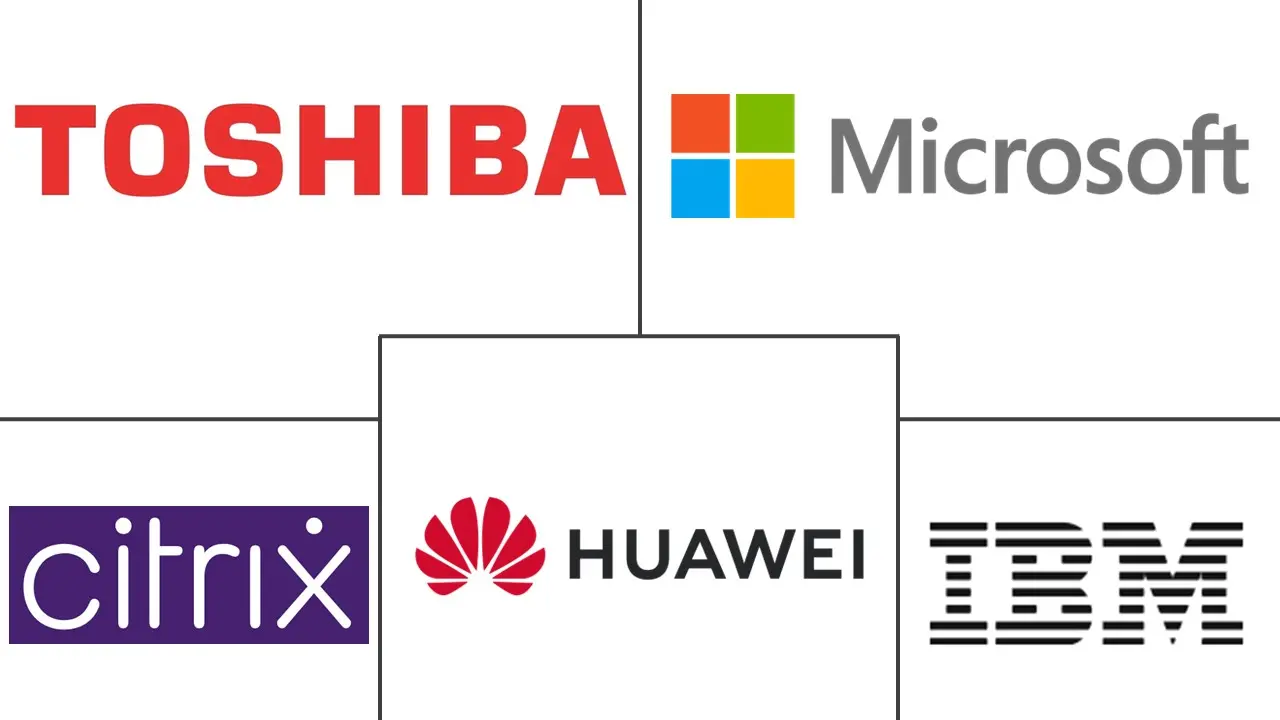
*Disclaimer: Major Players sorted in no particular order |
Desktop Virtualization Market Analysis
The Desktop Virtualization Market size is estimated at USD 13.79 billion in 2024, and is expected to reach USD 22.83 billion by 2029, growing at a CAGR of 10.60% during the forecast period (2024-2029).
Desktop Virtualization is completely in sync with cost reduction. Hence, cost-effectiveness is expected to be a key driving factor for the growth of the market.
- Desktop virtualization is valuable for small and medium businesses, as it lowers expenditure on hardware and reduces system administration and maintenance costs. It provides a superior computing experience and solves several complex problems. As a result, desktop virtualization has several benefits, such as a reduction of operational costs and increased user satisfaction, which is expected to fuel the growth of the desktop virtualization market during the forecast period.
- The growing adoption of cloud computing and increasing demand for BYOD in the workplace are significant factors driving this market. By implementing desktop virtualization, employers can leverage BYOD to boost the flexibility and security of both a remote workforce and those working in the office. Employees that use desktop virtualization have access to a secure, monitored desktop from almost any location and on any device.
- The ability to lower complexity and deliver apps to various mobile users is boosting the adoption of desktop virtualization in all types of businesses. The advancements in management and storage make it a more viable option, which is driving the adoption of the market worldwide.
- Infrastructural constraints are hindering the growth of the market. Desktop virtualization increases the complexity of delivering Windows desktops and applications. For virtual desktops to perform as intended, several layers of technology have to work in harmony. The need for new infrastructure, along with the costs associated with it, is one of the major constraints for the growth of the desktop virtualization market.
- The market has been brought to focus since COVID-19 because many businesses have turned to remote working. The lockdown and social distancing guidelines forced many businesses to make the necessary adjustments immediately and build the computer infrastructure needed to support their remote workers. Businesses have been using desktop virtualization solutions for a long time.
Desktop Virtualization Market Trends
Cloud Deployment Mode is Expected to Witness Significant Growth
- Various organizations are using cloud computing to reduce businesses' operational costs. Easy implementation, accessibility, and flexibility of cloud hosting are expected to drive organizations' adoption of cloud computing. Cloud deployment includes service models, such as Desktop-as-a-Service (DaaS), Workspace-as-a-Service (WaaS), and Application/Software-as-a-Service (SaaS). Desktop virtualization is offered as a service over cloud networks, with all computing and supporting infrastructure hosted on the service provider's end in the cloud deployment mode, which makes the migration of data between working environments easy.
- Application streaming over the cloud is gaining popularity in the industry, with many businesses choosing standalone application services. Cloud is preferred across industries, providing better scalability, data management, and cost savings. According to Flexera Software, in 2023, 47 percent of respondents are already running significant workloads on Amazon Web Services (AWS).
- Businesses can easily create new desktops for their workforce without needing to purchase physical PCs. When these resources are no longer needed, they can be turned off, at which point the customer is no longer billed. Although there are various pricing models, consumption-based pricing is a unique benefit of cloud desktops.
- Cloud deployment makes the migration of data between working environments easy. Also, companies have the option to scale up their requirements and procure additional computing power and data without the need for physical installation. This flexibility of DaaS enables better resource management.
- In June 2023, Cloud Software Group announced a partnership with Midis Group, in its collaboration to serve its channel and consumers in Eastern Europe, the Middle East, and Africa. The collaboration offers Cloud Software Group the local resources consumers need to help their transformative technology collaboration and the scale required to expand its presence in these regions.
- With servers and equipment hosted on the service provider's side, the need for technical staff and IT resources to maintain and operate systems is eliminated. In cloud-deployed desktop virtualization solutions, utilities and applications are updated automatically. Users do not need to be "pushed" for updates. The fact that users may access their virtual desktop or programs using almost any device means that regardless of whether they prefer PC, Mac, Linux, iOS, or Android, they will see the same applications that work in the same way and have them conveniently available whenever they need them.
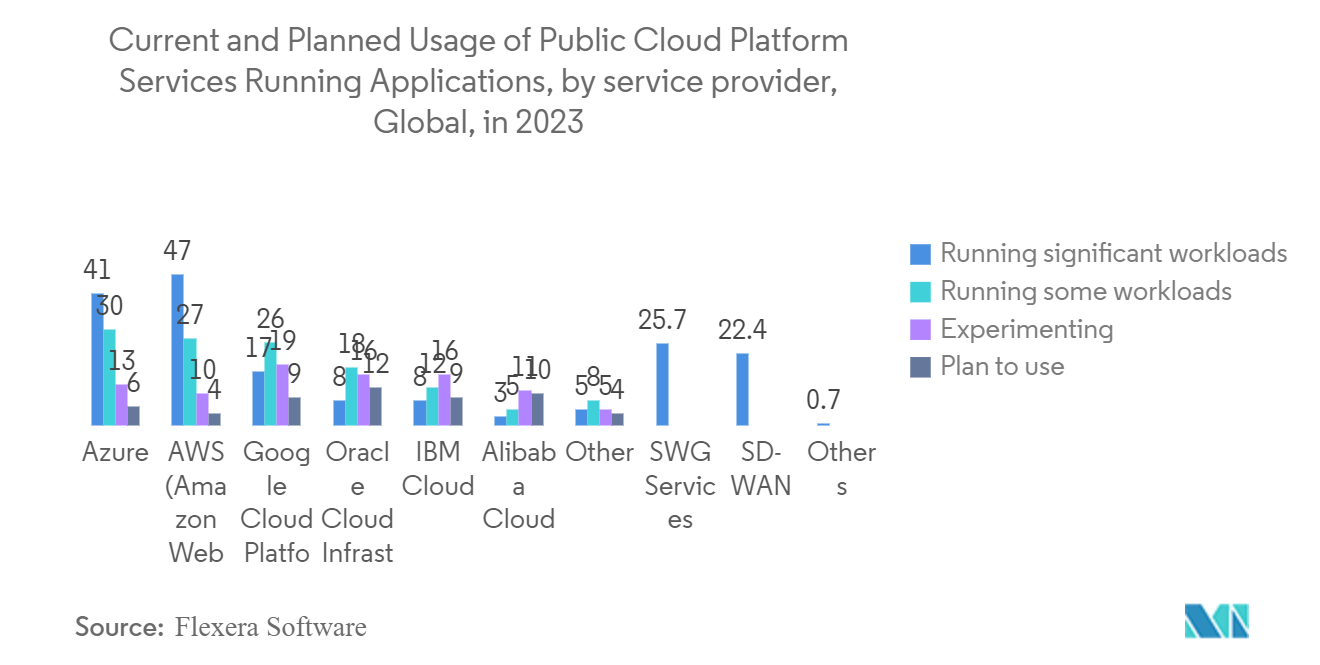
North America is Expected to Hold the Largest Market Share
- The North American region is considered to be the global hub for many industry verticals, and as a result, it is the largest regional market for desktop virtualization. The United States is the largest consumer of desktop virtualization in North America. The presence of several cloud service providers and an increasing number of hosted servers in the United States have contributed to the growth of the market in North America.
- The presence of major companies in the United States has led to the setting up of new workspaces in Canada due to the proximity of its developed counterpart and emphasis on installing eco-friendly and energy-saving practices, thus bolstering the growth of the market across the region.
- The early adoption of new technologies by organizations in the region is the primary driving force behind global dominance. Large cloud service providers play a significant role in the growth of cloud-based desktop virtualization deployment in the region.
- The North American IT and telecommunications industry is the largest among other regional markets. Industries, such as banking, healthcare, and government organizations, handle large databases of sensitive information. They are looking forward to using desktop virtualization deployments, as they preserve the integrity of the intellectual property and simultaneously provide flexibility to users.
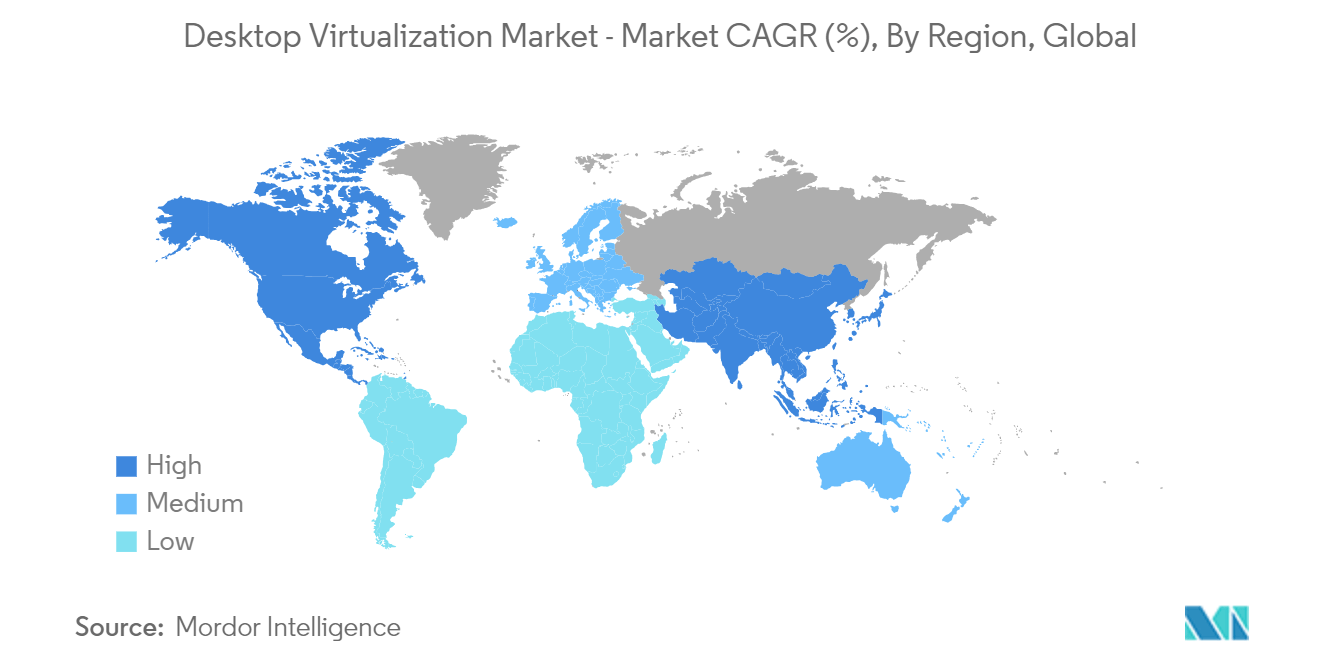
Desktop Virtualization Industry Overview
The Desktop Virtualization market is highly fragmented with the presence of major players like Citrix Systems Inc., IBM Corporation, Huawei Technologies Co. Ltd, Microsoft Corporation, and Toshiba Corporation. Players in the market are adopting strategies such as partnerships and acquisitions to enhance their product offerings and gain sustainable competitive advantage.
- November 2023 - Microsft has announced the General Availability of the latest new Azure Virtual Desktop Web Client User Interface. With this update, Users can Reset web client settings to their defaults, Switch between Light and Dark Mode, and View their resources in a grid or list format.
- July 2023 - Citrix has partnered with Twilio, one of the global leaders in customer engagement software. This partnership represents the commitment to provide integrated, high-performance solutions for the Citrix DaaS and Twilio Flex environments.
Desktop Virtualization Market Leaders
-
Citrix Systems Inc.
-
IBM Corporation
-
Huawei Technologies Co. Ltd
-
Microsoft Corporation
-
Toshiba Corporation
*Disclaimer: Major Players sorted in no particular order
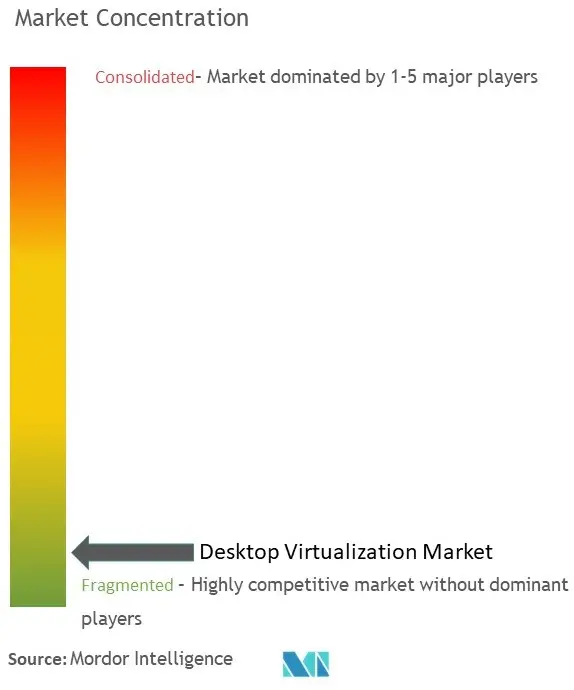
Desktop Virtualization Market News
- November 2023 - IGEL, a provider of the managed endpoint operating system for secured access to any digital workspace, and Imprivata announced the availability of an integrated solution for IGEL and Imprivata consumers that enables multi-factor authentication (MFA) and single sign-on (SSO) for clinicians accessing their virtual apps and desktops. The new IGEL Agent for Imprivata OneSign Enterprise Access Management enables and controls digital identities with secure, no-click access to Microsoft Azure Virtual Desktop (AVD) and Windows 365 Cloud PC cloud resources.
- April 2023 - Virtual Cable and Huawei Cloud have signed a technology alliance to drive public cloud adoption in digital work environments, improving organizations' security, productivity, and efficiency. Virtual Cable is an organization specializing in the digital transformation of the workplace. The company develops, supports, and markets UDS Enterprise software for desktop virtualization, application virtualization, and remote access to physical devices. Its team of experts has designed customized VDI solutions for each sector to offer a unique user experience fully adapted to the needs of each user profile.
Desktop Virtualization Market Report - Table of Contents
1. INTRODUCTION
- 1.1 Study Assumptions and Market Defnition
- 1.2 Scope of the Study
2. RESEARCH METHODOLOGY
3. EXECUTIVE SUMMARY
4. MARKET INSIGHTS
- 4.1 Market Overview
-
4.2 Industry Attractiveness - Porter's Five Forces Analysis
- 4.2.1 Bargaining Power of Suppliers
- 4.2.2 Bargaining Power of Buyers/Consumers
- 4.2.3 Threat of New Entrants
- 4.2.4 Threat of Substitute Products
- 4.2.5 Intensity of Competitive Rivalry
- 4.3 Impact of COVID-19 on the Market
5. MARKET DYNAMICS
-
5.1 Market Drivers
- 5.1.1 Increasing Demand for Bring Your Own Device
- 5.1.2 Growing Adoption of Cloud Computing
-
5.2 Market Restraints
- 5.2.1 Infrastructural Constraints
6. MARKET SEGMENTATION
-
6.1 By Desktop Delivery Platform
- 6.1.1 Hosted Virtual Desktop (HVD)
- 6.1.2 Hosted Shared Desktop (HSD)
- 6.1.3 Other Desktop Delivery Forms
-
6.2 By Deployment Mode
- 6.2.1 On-premise
- 6.2.2 Cloud
-
6.3 By End-User Vertical
- 6.3.1 Financial Services
- 6.3.2 Healthcare
- 6.3.3 Manufacturing
- 6.3.4 IT & Telecommunications
- 6.3.5 Other End-User Verticals
-
6.4 By Geography
- 6.4.1 North America
- 6.4.2 Europe
- 6.4.3 Asia-Pacific
- 6.4.4 Latin America
- 6.4.5 Middle East and Africa
7. COMPETITIVE LANDSCAPE
-
7.1 Company Profiles
- 7.1.1 Citrix Systems Inc.
- 7.1.2 IBM Corporation
- 7.1.3 Huawei Technologies Co. Ltd
- 7.1.4 Microsoft Corporation
- 7.1.5 Toshiba Corporation
- 7.1.6 DELL Technologies Inc.
- 7.1.7 Parallels International GmbH
- 7.1.8 Red Hat Inc.
- 7.1.9 NComputing Co. Ltd.
- 7.1.10 Ericom Software Inc.
- *List Not Exhaustive
8. INVESTMENT ANALYSIS
9. MARKET OPPORTUNITIES AND FUTURE TRENDS
** Subject To AvailablityDesktop Virtualization Industry Segmentation
Desktop virtualization is a virtualization technique that separates a personal computing desktop from a physical machine using the client-server computing model. This has become a mainstream IT strategy for companies of all sizes. Desktop virtualization involves the separation of the physical client device from the operating system. The data needed for the desktop is stored in a centralized or remote server and not on the client's device. This allows users to access their data from anywhere and at any time.
The Desktop Virtualization Market is segmented into the desktop delivery platform (hosted virtual desktop, hosted shared desktop), deployment mode (on-premises, cloud), end-user vertical (BFSI, healthcare, manufacturing, IT, and telecommunications), and geography (North America, Europe, Asia Pacific, Latin America, and Middle East and Africa). The report offers market forecasts and size in value (USD) for all the above segments.
| By Desktop Delivery Platform | Hosted Virtual Desktop (HVD) |
| Hosted Shared Desktop (HSD) | |
| Other Desktop Delivery Forms | |
| By Deployment Mode | On-premise |
| Cloud | |
| By End-User Vertical | Financial Services |
| Healthcare | |
| Manufacturing | |
| IT & Telecommunications | |
| Other End-User Verticals | |
| By Geography | North America |
| Europe | |
| Asia-Pacific | |
| Latin America | |
| Middle East and Africa |
Desktop Virtualization Market Research FAQs
How big is the Desktop Virtualization Market?
The Desktop Virtualization Market size is expected to reach USD 13.79 billion in 2024 and grow at a CAGR of 10.60% to reach USD 22.83 billion by 2029.
What is the current Desktop Virtualization Market size?
In 2024, the Desktop Virtualization Market size is expected to reach USD 13.79 billion.
Who are the key players in Desktop Virtualization Market?
Citrix Systems Inc., IBM Corporation, Huawei Technologies Co. Ltd, Microsoft Corporation and Toshiba Corporation are the major companies operating in the Desktop Virtualization Market.
Which is the fastest growing region in Desktop Virtualization Market?
Asia Pacific is estimated to grow at the highest CAGR over the forecast period (2024-2029).
Which region has the biggest share in Desktop Virtualization Market?
In 2024, the North America accounts for the largest market share in Desktop Virtualization Market.
What years does this Desktop Virtualization Market cover, and what was the market size in 2023?
In 2023, the Desktop Virtualization Market size was estimated at USD 12.33 billion. The report covers the Desktop Virtualization Market historical market size for years: 2019, 2020, 2021, 2022 and 2023. The report also forecasts the Desktop Virtualization Market size for years: 2024, 2025, 2026, 2027, 2028 and 2029.
Desktop Virtualization Industry Report
Statistics for the 2023 Desktop Virtualization market share, size and revenue growth rate, created by Mordor Intelligence™ Industry Reports. Desktop Virtualization analysis includes a market forecast outlook to 2029 and historical overview. Get a sample of this industry analysis as a free report PDF download.



